Mary Dwyer quietly wept as she took part in a Corpus Christi procession at Incarnation Parish in Sarasota on June 19, 2022, the Solemnity of the Most Holy Body and Blood of Christ.
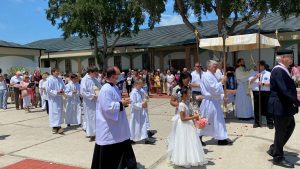 “The power of Our Lord, and His Presence in the Blessed Sacrament, brings me great comfort,” Dwyer said. “I feel so happy to be able to honor Jesus in this special way.”
“The power of Our Lord, and His Presence in the Blessed Sacrament, brings me great comfort,” Dwyer said. “I feel so happy to be able to honor Jesus in this special way.”
The Solemnity of the Most Holy Body and Blood of Christ (Corpus Christi) is a celebration of the Eucharist and the Real Presence of Our Lord which is a tradition that dates back centuries and is often marked by a Eucharistic Procession. This year’s celebration fell on Father’s Day.
At Incarnation, the procession began with a flower girl, sprinkling rose petals onto the ground, then the cross bearer, altar servers and a Knights of Columbus Honor Guard ahead of Father Eric Scanlan, Pastor of Incarnation, carrying the monstrance with the Blessed Sacrament while it was under a canopy, as the Parish Choir led everyone in song.
 The procession made its way from the main church into the Parish courtyard and then into the parking lot, stopping at four temporary altars where Father Scanlan led everyone in prayer and readings from the Gospel. The procession concluded in the Parish Chapel where Father led the Benediction.
The procession made its way from the main church into the Parish courtyard and then into the parking lot, stopping at four temporary altars where Father Scanlan led everyone in prayer and readings from the Gospel. The procession concluded in the Parish Chapel where Father led the Benediction.
Participating in a procession is viewed as an opportunity to reflect on this gift of the Holy Eucharist as the faithful pause at four “stations” for a reading and prayer and then conclude with Benediction. It is an opportunity to remind ourselves how special we are that God should want to nourish us with the body and blood of His Son, and it is an opportunity to thank God for these wonderful gifts.
During the Mass, Father Scanlan reflected on the importance of approaching one’s faith by focusing on the Real Presence – the true body and blood of Christ – that is found in the Most Blessed Sacrament.
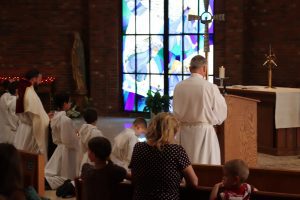 “Brothers and sisters, Our God dwells among us,” Father said during the Mass. “He comes to honor us. To strengthen and heal us… But, the Lord can only do so much, unless we open our hearts to Him. We can say Lord, help me to believe; help me to receive You with love and affection; help me to allow you to heal me and to transform me, this heart and soul of mine. He wants so much for us to encounter Him, here today, each one of us. Brothers and sisters, this Great Feast offers us the opportunity to rekindle our love and our wonder and our gratitude of the Presence of Jesus in the Blessed Sacrament. He is here. He is here.”
“Brothers and sisters, Our God dwells among us,” Father said during the Mass. “He comes to honor us. To strengthen and heal us… But, the Lord can only do so much, unless we open our hearts to Him. We can say Lord, help me to believe; help me to receive You with love and affection; help me to allow you to heal me and to transform me, this heart and soul of mine. He wants so much for us to encounter Him, here today, each one of us. Brothers and sisters, this Great Feast offers us the opportunity to rekindle our love and our wonder and our gratitude of the Presence of Jesus in the Blessed Sacrament. He is here. He is here.”
The Corpus Christi celebration, and its associated Eucharistic Processions, which took place at Parishes within the Diocese, also marked the opening of the National Eucharistic Revival. This Eucharistic Revival is an effort by the U.S. Bishops to answer the call of Jesus Christ to return to the source and summit of Our Faith – the Real Presence in the Holy Eucharist.
The Diocesan Year of the National Eucharistic Revival is from June 19, 2022, to June 11, 2023. During the Diocesan Year there will be a series of events and retreats that encourage the renewal of the Church “by rekindling a living relationship with the Lord Jesus Christ in the Holy Eucharist.” Please check the Diocese website regularly for the plans for implementing this Revival in the Diocese at https://dioceseofvenice.org/offices/offices-departments/eucharistic-congress-2023/.
Instituted in 1264 by Pope Urban IV, Corpus Christi is also known as the Feast of the Most Holy Body and Blood of Christ.
 The Feast Day is an important affirmation of our belief that Our Lord is really and truly sacramentally present in the form of bread and wine. When Our Lord instituted the Eucharist, He said this IS My Body and this IS My Blood; not this represents or is symbolic of my body and blood. The Sacrament was defined as “an outward sign” of inward grace given to us by Jesus Christ for our sanctification and salvation.
The Feast Day is an important affirmation of our belief that Our Lord is really and truly sacramentally present in the form of bread and wine. When Our Lord instituted the Eucharist, He said this IS My Body and this IS My Blood; not this represents or is symbolic of my body and blood. The Sacrament was defined as “an outward sign” of inward grace given to us by Jesus Christ for our sanctification and salvation.
The Feast of Corpus Christi is observed two weeks after Pentecost. The Feast of Pentecost, which was on June 5 this year, is celebrated 50 days after Easter Sunday, and commemorates the descent of the Holy Spirit upon the Apostles and other followers of Jesus Christ while they were in Jerusalem, as described in the Acts of the Apostles.





 Mary’s example provides an opportunity for the Church to reflect on the role of all mothers in society and the Church, the Pope explained, noting how despite all of the “symbolic glorification” we give to motherhood, it is still under-valued.
Mary’s example provides an opportunity for the Church to reflect on the role of all mothers in society and the Church, the Pope explained, noting how despite all of the “symbolic glorification” we give to motherhood, it is still under-valued.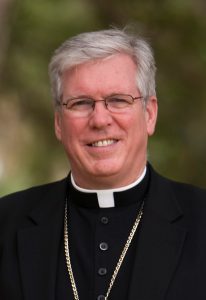 Bishop Dewane stressed that the Faithful must look at radically changing their life, but with a certain zeal, or fire, welling up from within, similar to how the Blessed Virgin answered “Yes!” to the call of the Lord at the Annunciation.
Bishop Dewane stressed that the Faithful must look at radically changing their life, but with a certain zeal, or fire, welling up from within, similar to how the Blessed Virgin answered “Yes!” to the call of the Lord at the Annunciation. Dedicated by St. John Paul II, Divine Mercy Sunday honors St. Faustina’s vision of Jesus Christ – His message of love and peace for the world. For many in the Diocese of Venice, the Feast of Divine Mercy takes on a powerful meaning when they participate in a private or public prayer called the Chaplet of Divine Mercy.
Dedicated by St. John Paul II, Divine Mercy Sunday honors St. Faustina’s vision of Jesus Christ – His message of love and peace for the world. For many in the Diocese of Venice, the Feast of Divine Mercy takes on a powerful meaning when they participate in a private or public prayer called the Chaplet of Divine Mercy.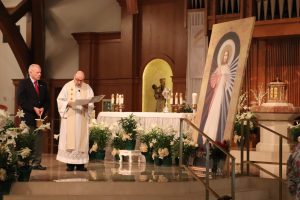 St. Faustina wrote in her diary what Jesus told her: “I desire that the Feast of Mercy be a refuge and shelter for all souls but especially for poor sinners. I pour out a whole ocean of graces upon these souls who approach the fount of My Mercy… let no soul fear to draw near to Me, even though its sins be many.”
St. Faustina wrote in her diary what Jesus told her: “I desire that the Feast of Mercy be a refuge and shelter for all souls but especially for poor sinners. I pour out a whole ocean of graces upon these souls who approach the fount of My Mercy… let no soul fear to draw near to Me, even though its sins be many.”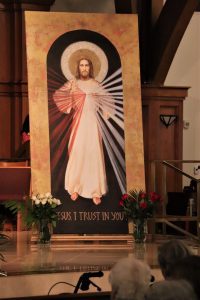 At St. William Parish in Naples, Divine Mercy Sunday included the traditional afternoon prayer service. This opened with a procession with the Color Corps of the Knights of Columbus followed by children and adults who placed red and white flowers before the image, then the image was blessed with holy water. Next, was an Exposition of the Blessed Sacrament, a reflection from Father Steven Clemente, a recitation of the Divine Mercy Litany, and singing of the Divine Mercy Chaplet. The prayer service concluded with a veneration of the image of Divine Mercy. A large painting of the Divine Mercy image, created in 2019 for the Parish by Rosalie Polivika Ramstead, was on display during the prayer service.
At St. William Parish in Naples, Divine Mercy Sunday included the traditional afternoon prayer service. This opened with a procession with the Color Corps of the Knights of Columbus followed by children and adults who placed red and white flowers before the image, then the image was blessed with holy water. Next, was an Exposition of the Blessed Sacrament, a reflection from Father Steven Clemente, a recitation of the Divine Mercy Litany, and singing of the Divine Mercy Chaplet. The prayer service concluded with a veneration of the image of Divine Mercy. A large painting of the Divine Mercy image, created in 2019 for the Parish by Rosalie Polivika Ramstead, was on display during the prayer service.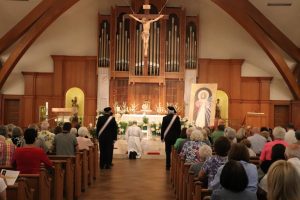 During the prayer service at St. William Parish several reflections and passages from the diary of St. Faustina were read. At the conclusion, the faithful were invited to come forward and pray before the image of Divine Mercy.
During the prayer service at St. William Parish several reflections and passages from the diary of St. Faustina were read. At the conclusion, the faithful were invited to come forward and pray before the image of Divine Mercy.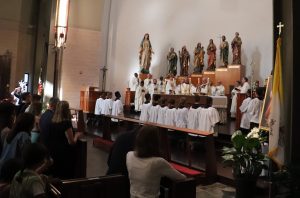 Celebrated on March 25, 2022, the Solemnity marks the Angel Gabriel’s appearance to the Virgin Mary (Luke 1:26-38), and his announcement that the Blessed Virgin has been chosen to be the Mother of Our Lord, and Mary’s willing acceptance of God’s Holy Plan.
Celebrated on March 25, 2022, the Solemnity marks the Angel Gabriel’s appearance to the Virgin Mary (Luke 1:26-38), and his announcement that the Blessed Virgin has been chosen to be the Mother of Our Lord, and Mary’s willing acceptance of God’s Holy Plan.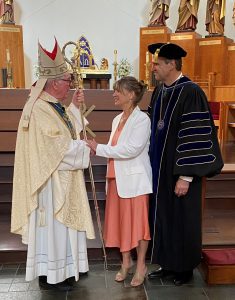 Following the Oath of Fidelity and Profession of Faith, an Investiture Ceremony took place wherein Middendorf was bestowed with the Seal of the Office of the President of Ave Maria University by Board of Trustees Chairman Patrick Rainey. Prior to this, Father David Vidal, Pastor of Ave Maria Parish, and others representing the students, faculty, alumni and Board of Trustees, spoke highly of the appointment of Middendorf as the new President of the University.
Following the Oath of Fidelity and Profession of Faith, an Investiture Ceremony took place wherein Middendorf was bestowed with the Seal of the Office of the President of Ave Maria University by Board of Trustees Chairman Patrick Rainey. Prior to this, Father David Vidal, Pastor of Ave Maria Parish, and others representing the students, faculty, alumni and Board of Trustees, spoke highly of the appointment of Middendorf as the new President of the University. Both saints are celebrated in particular ways in mid-March, with the Feast Day of St. Patrick celebrated on March 17 and the Solemnity of St. Joseph on March 19. During that week, Parishes and schools throughout the Diocese of Venice held a variety of celebrations in honor of each saint.
Both saints are celebrated in particular ways in mid-March, with the Feast Day of St. Patrick celebrated on March 17 and the Solemnity of St. Joseph on March 19. During that week, Parishes and schools throughout the Diocese of Venice held a variety of celebrations in honor of each saint. A St. Patrick’s Day Parade in Naples featured participation from each Catholic School in Collier County. Other schools in the Diocese held Leprechaun Days and other fun events to honor the Irish saint who is credited with converting Ireland to Christianity.
A St. Patrick’s Day Parade in Naples featured participation from each Catholic School in Collier County. Other schools in the Diocese held Leprechaun Days and other fun events to honor the Irish saint who is credited with converting Ireland to Christianity.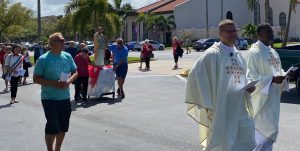 Epiphany Cathedral in Venice hosted a Mass for the Solemnity of St. Joseph which was celebrated in Italian and included the active involvement of the Italian-American Club of Venice. Following the March 18, 2022 Mass, the statue of St. Joseph was carried to the Parish Hall in a procession led by the Knights of Columbus. There, Msgr. Patrick Dubois, Cathedral Rector, blessed the traditional St. Joseph’s table of bread and sweets, which was later distributed.
Epiphany Cathedral in Venice hosted a Mass for the Solemnity of St. Joseph which was celebrated in Italian and included the active involvement of the Italian-American Club of Venice. Following the March 18, 2022 Mass, the statue of St. Joseph was carried to the Parish Hall in a procession led by the Knights of Columbus. There, Msgr. Patrick Dubois, Cathedral Rector, blessed the traditional St. Joseph’s table of bread and sweets, which was later distributed. St. Columbkille Parish in Fort Myers got into the spirit of both Feast Days, first with a St. Patrick’s Dinner Dance and then an Italia Festa two days later. While the favored colors representing the two saints differed (green for St. Patrick and red and white for St. Joseph), both gatherings involved lots of tasty food, ethnic music and fun.
St. Columbkille Parish in Fort Myers got into the spirit of both Feast Days, first with a St. Patrick’s Dinner Dance and then an Italia Festa two days later. While the favored colors representing the two saints differed (green for St. Patrick and red and white for St. Joseph), both gatherings involved lots of tasty food, ethnic music and fun.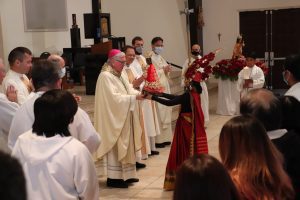 Incarnation Parish in Sarasota was host to the first ever Diocese of Venice Santo Niño Festival on Jan. 16, 2022. Organized by the local Filipino Catholic Community and the Couples for Christ group, more than 250 people participated in the Mass and Festival which recounts an important conversion story.
Incarnation Parish in Sarasota was host to the first ever Diocese of Venice Santo Niño Festival on Jan. 16, 2022. Organized by the local Filipino Catholic Community and the Couples for Christ group, more than 250 people participated in the Mass and Festival which recounts an important conversion story. Conflict in the region soon followed during which Magellan was killed and his Spanish colleagues left. The next Spanish expedition occurred in 1565 by Miguel Lopez de Legazpi who conquered Cebu and after pillaging the villages, the original Magellan Santo Niño was found safe and unscathed from the fires. The Franciscan Friars who witnessed this proclaimed the statue miraculous and built a church on the site, which is now the “Basílica Menor del Santo Niño in Cebu.”
Conflict in the region soon followed during which Magellan was killed and his Spanish colleagues left. The next Spanish expedition occurred in 1565 by Miguel Lopez de Legazpi who conquered Cebu and after pillaging the villages, the original Magellan Santo Niño was found safe and unscathed from the fires. The Franciscan Friars who witnessed this proclaimed the statue miraculous and built a church on the site, which is now the “Basílica Menor del Santo Niño in Cebu.”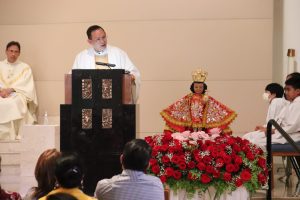 It was explained that this Feast Day celebration reminds Filipinos of the Christianization of their homeland but also enables them to see the relevance this devotion to the Santo Niño has for people to this day. It forces us to focus on the children and youth, with all the problems they may pose and the hopes they raise.
It was explained that this Feast Day celebration reminds Filipinos of the Christianization of their homeland but also enables them to see the relevance this devotion to the Santo Niño has for people to this day. It forces us to focus on the children and youth, with all the problems they may pose and the hopes they raise.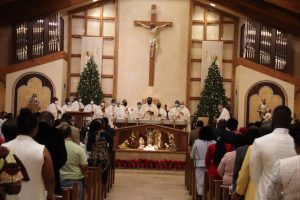 Faithful people from throughout the Diocese of Venice attended the Mass which was celebrated by Most Rev. Pierre-André Dumas, Bishop of the Diocese of Anse-a-Veau and Miragoane, with Bishop Frank J. Dewane concelebrating. There were several additional priests from the Diocese of Venice who also concelebrated.
Faithful people from throughout the Diocese of Venice attended the Mass which was celebrated by Most Rev. Pierre-André Dumas, Bishop of the Diocese of Anse-a-Veau and Miragoane, with Bishop Frank J. Dewane concelebrating. There were several additional priests from the Diocese of Venice who also concelebrated.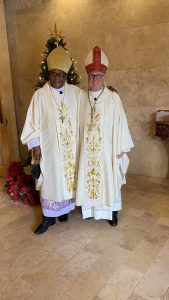 In a gesture of gratitude toward Bishop Dewane, Bishop Dumas noted that the Haitian Catholic Community within the Diocese of Venice is in good and capable hands and thanked Bishop Dewane for his support.
In a gesture of gratitude toward Bishop Dewane, Bishop Dumas noted that the Haitian Catholic Community within the Diocese of Venice is in good and capable hands and thanked Bishop Dewane for his support. For the Haitian community, Jan. 1 is both a spiritual day, and an emotional day commemorating such an important day in their homeland. The Haitians defeated the largest and most powerful army at the time, the army of Napoleon, in Cap-Haitien, and Haiti became the second country in the Americas to declare its Independence on Jan. 1, 1804.
For the Haitian community, Jan. 1 is both a spiritual day, and an emotional day commemorating such an important day in their homeland. The Haitians defeated the largest and most powerful army at the time, the army of Napoleon, in Cap-Haitien, and Haiti became the second country in the Americas to declare its Independence on Jan. 1, 1804. The 2021 Christmas Eve and Christmas Day Mass times for Parishes throughout the Diocese of Venice can be found on the Diocese of Venice homepage at https://dioceseofvenice.org/2021-diocesan-parish-christmas-mass-times/. The listings are in alphabetical order by the city the Parish is located. For details on youth choirs or musical accompaniment, please contact the Parish via the phone number or website listed for further information.
The 2021 Christmas Eve and Christmas Day Mass times for Parishes throughout the Diocese of Venice can be found on the Diocese of Venice homepage at https://dioceseofvenice.org/2021-diocesan-parish-christmas-mass-times/. The listings are in alphabetical order by the city the Parish is located. For details on youth choirs or musical accompaniment, please contact the Parish via the phone number or website listed for further information.





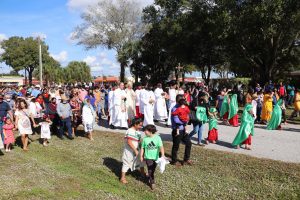 Our Lady of Guadalupe is one of the most revered patronesses within the Catholic Faith, and this is particularly so in the Hispanic community. The Feast Day, Dec. 12, is often described as all other holidays wrapped up into one.
Our Lady of Guadalupe is one of the most revered patronesses within the Catholic Faith, and this is particularly so in the Hispanic community. The Feast Day, Dec. 12, is often described as all other holidays wrapped up into one.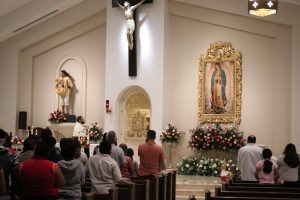 The Blessed Virgin instructed St. Juan Diego to gather the Castilian roses that he found blooming on the hillside, despite the fact that it was winter, and present them to the Spanish Bishop. St. Juan Diego filled his cloak – known as a tilma – with the flowers. When he presented them to the Bishop and the roses spilled upon the floor, an image of Our Lady was miraculously imprinted upon his tilma. Nearly 500 years later, Diego’s tilma with the miraculous image is preserved in the Basilica of Our Lady of Guadalupe in Mexico City and visited by millions of pilgrims each year.
The Blessed Virgin instructed St. Juan Diego to gather the Castilian roses that he found blooming on the hillside, despite the fact that it was winter, and present them to the Spanish Bishop. St. Juan Diego filled his cloak – known as a tilma – with the flowers. When he presented them to the Bishop and the roses spilled upon the floor, an image of Our Lady was miraculously imprinted upon his tilma. Nearly 500 years later, Diego’s tilma with the miraculous image is preserved in the Basilica of Our Lady of Guadalupe in Mexico City and visited by millions of pilgrims each year.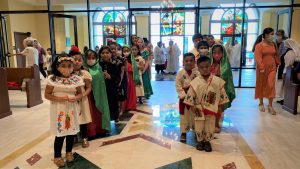 Bishop Frank J. Dewane led the celebration at St. Paul Parish in Arcadia, where he had dedicated the new Parish Church on March 21. This Mass brought together a massive crowd which was followed by an 1/3-mile procession to an outdoor festival that lasted into the night.
Bishop Frank J. Dewane led the celebration at St. Paul Parish in Arcadia, where he had dedicated the new Parish Church on March 21. This Mass brought together a massive crowd which was followed by an 1/3-mile procession to an outdoor festival that lasted into the night.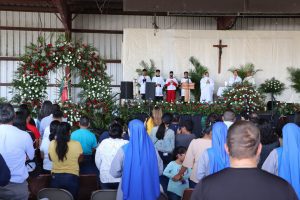 Explaining how Advent is about anticipating the second coming of Christ, the Bishop stressed the need to hold Jesus in our hearts. He remarked how strongly he could see that in the faithful of St. Paul Parish as evidence by their devotion to Our Lady of Guadalupe and to Her Son.
Explaining how Advent is about anticipating the second coming of Christ, the Bishop stressed the need to hold Jesus in our hearts. He remarked how strongly he could see that in the faithful of St. Paul Parish as evidence by their devotion to Our Lady of Guadalupe and to Her Son.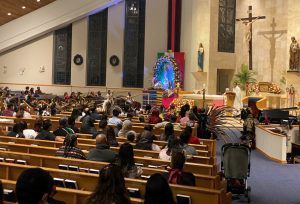
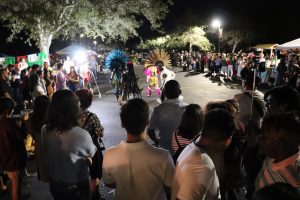 St. Elizabeth Seton Parish in Naples served as host for a combined celebration with the Hispanic faithful of St. Agnes Parish. Father Carlos Encinas was the celebrant and serves the Spanish-speaking population of both communities. The Mass was the largest in the history with an estimated 1,500 participating. Following Mass, youth participated in a play which retold the story of St. Juan Diego and Our Lady, something which takes place at many Parish celebrations. Outside, Aztec dancers performed under the lights in the parking lot while a festival of food took place.
St. Elizabeth Seton Parish in Naples served as host for a combined celebration with the Hispanic faithful of St. Agnes Parish. Father Carlos Encinas was the celebrant and serves the Spanish-speaking population of both communities. The Mass was the largest in the history with an estimated 1,500 participating. Following Mass, youth participated in a play which retold the story of St. Juan Diego and Our Lady, something which takes place at many Parish celebrations. Outside, Aztec dancers performed under the lights in the parking lot while a festival of food took place. Jesus the Worker Parish in Fort Myers had two shrines to Our Lady. One was in the main church, below the permanent Our Lady of Guadalupe image on the wall, left of the altar. There, the faithful placed hundreds of flowers and other religious articles. A temporary shrine was constructed outside. The celebration began with singing in the church and continued overnight and into the next day.
Jesus the Worker Parish in Fort Myers had two shrines to Our Lady. One was in the main church, below the permanent Our Lady of Guadalupe image on the wall, left of the altar. There, the faithful placed hundreds of flowers and other religious articles. A temporary shrine was constructed outside. The celebration began with singing in the church and continued overnight and into the next day.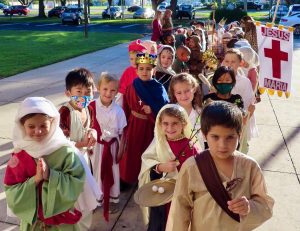
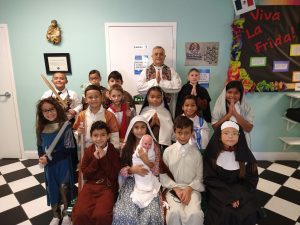
 Meanwhile, St. Michael Parish in Wauchula decided to host a carnival/trick-or-treat event in the field behind the Parish. Children dressed as priests, angels and a variety of superheroes and other characters each had to complete a carnival game to receive candy. One game had children try to identify images of saints with only a small hint to help. All the candy was donated by the faithful at St. Raphael Parish in Englewood.
Meanwhile, St. Michael Parish in Wauchula decided to host a carnival/trick-or-treat event in the field behind the Parish. Children dressed as priests, angels and a variety of superheroes and other characters each had to complete a carnival game to receive candy. One game had children try to identify images of saints with only a small hint to help. All the candy was donated by the faithful at St. Raphael Parish in Englewood.


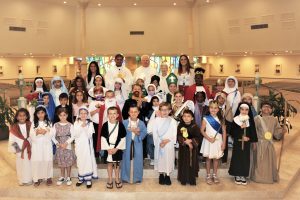 Pope Francis said true happiness does not come from being young, rich, or successful, as the world thinks, but from the counter-cultural idea to follow Jesus Christ. The Holy Father made his remarks during a special Angelus address for the Solemnity of All Saints, celebrated by the Catholic Church on Nov. 1, 2021. This year the obligation to attend Mass was abrogated in the United States because the Solemnity fell on a Monday.
Pope Francis said true happiness does not come from being young, rich, or successful, as the world thinks, but from the counter-cultural idea to follow Jesus Christ. The Holy Father made his remarks during a special Angelus address for the Solemnity of All Saints, celebrated by the Catholic Church on Nov. 1, 2021. This year the obligation to attend Mass was abrogated in the United States because the Solemnity fell on a Monday.